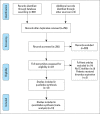A meta-analysis of randomized controlled trials investigating tirofiban combined with conventional drugs by intracoronary administration for no-reflow prevention
- PMID: 33382055
- PMCID: PMC7803802
- DOI: 10.14744/AnatolJCardiol.2020.99469
A meta-analysis of randomized controlled trials investigating tirofiban combined with conventional drugs by intracoronary administration for no-reflow prevention
Abstract
Objective: Studies examining the effects of tirofiban combined with other conventional drugs for treating patients with acute coronary syndrome (ACS) are lacking. Thus, in this study, we conducted a meta-analysis investigating both the safety and efficacy of intracoronary (IC) administration of tirofiban treatment alone versus in combination with other conventional treatments for the no-reflow phenomenon (NRP) during percutaneous coronary intervention (PCI) in patients with ACS.
Methods: PubMed, Cochrane Library, Embase, Chinese Biomedical (CBM), Google Scholar, and China National Knowledge Infrastructure (CNKI) databases were searched for randomized controlled trials (RCTs) that included data comparing tirofiban treatment alone versus in combination with other conventional therapies. Two independent reviewers evaluated the quality of all data and studies were evaluated according to the Cochrane Collaboration Handbook 5.3.
Results: Thirteen RCTs involving 937 patients were included in our analysis. Tirofiban plus conventional drug treatment improved thrombolysis in myocardial infarction (TIMI) grade 3 flow (OR: 0.18; 95% CI: 0.11–0.30; p<0.01), corrected TIMI frame count (CTFC) (WMD: 6.61; 95% CI: 4.69–8.53; p<0.01), and corrected left ventricular ejection fraction (LVEF) (WMD: −3.76; 95% CI: −4.70 to −2.82; p<0.01) and reduced major adverse cardiovascular events (MACE) (OR: 3.9; 95% CI; 2.51–6.07; p<0.01). Tirofiban plus conventional therapy reduced bleeding; however, no statistical significance was observed (OR: 1.24; 95% CI: 0.50–3.12; p=0.64).
Conclusion: IC administration of tirofiban combined with conventional drugs is more effective than tirofiban treatment alone for no-reflow (NR) during PCI without increasing bleeding events. This combination is recommended as an optimal strategy for preventing NR.
Conflict of interest statement
Figures







Similar articles
-
Meta-analysis of randomized controlled trials on the efficacy and safety of intracoronary administration of tirofiban for no-reflow phenomenon.BMC Cardiovasc Disord. 2013 Sep 10;13:68. doi: 10.1186/1471-2261-13-68. BMC Cardiovasc Disord. 2013. PMID: 24016038 Free PMC article.
-
Efficacy and Safety of Intracoronary versus Intravenous Administration of Tirofiban during Percutaneous Coronary Intervention for Acute Coronary Syndrome: A Meta-Analysis of Randomized Controlled Trials.PLoS One. 2015 Jun 11;10(6):e0129718. doi: 10.1371/journal.pone.0129718. eCollection 2015. PLoS One. 2015. PMID: 26067296 Free PMC article.
-
Acute Effects of Intracoronary Tirofiban on No-Reflow Phenomena in Patients With ST-Segment Elevated Myocardial Infarction Undergoing Primary Percutaneous Coronary Intervention.Angiology. 2015 Jul;66(6):560-7. doi: 10.1177/0003319714545780. Epub 2014 Aug 4. Angiology. 2015. PMID: 25092681 Clinical Trial.
-
Intralesional versus intracoronary administration of glycoprotein IIb/IIIa inhibitors during percutaneous coronary intervention in patients with acute coronary syndromes: A meta-analysis of randomized controlled trials.Medicine (Baltimore). 2017 Oct;96(40):e8223. doi: 10.1097/MD.0000000000008223. Medicine (Baltimore). 2017. PMID: 28984776 Free PMC article. Review.
-
Platelet glycoprotein IIb/IIIa-receptor inhibitors in patients with acute coronary syndromes or undergoing percutaneous coronary interventions: a review.Clin Ther. 2001 Aug;23(8):1145-65; discussion 1129. doi: 10.1016/s0149-2918(01)80098-9. Clin Ther. 2001. PMID: 11558855 Review.
Cited by
-
D-dimer for risk stratification and antithrombotic treatment management in acute coronary syndrome patients: asystematic review and metanalysis.Thromb J. 2021 Dec 18;19(1):102. doi: 10.1186/s12959-021-00354-y. Thromb J. 2021. PMID: 34922573 Free PMC article.
-
Bleeding risk with concomitant use of tirofiban and third-generation P2Y12 receptor antagonists in patients with acute myocardial infarction: A real-life data.Anatol J Cardiol. 2021 Oct;25(10):699-705. doi: 10.5152/AnatolJCardiol.2021.27974. Anatol J Cardiol. 2021. PMID: 34622784 Free PMC article.
-
Growth differentiation factor-15 as a biomarker of coronary microvascular dysfunction in ST-segment elevation myocardial infarction.Heliyon. 2024 Jul 30;10(15):e35476. doi: 10.1016/j.heliyon.2024.e35476. eCollection 2024 Aug 15. Heliyon. 2024. PMID: 39170466 Free PMC article.
-
Effectiveness of different tirofiban administration times in patients with no-reflow myocardial infarction during percutaneous coronary intervention.Pak J Med Sci. 2024 Oct;40(9):1969-1974. doi: 10.12669/pjms.40.9.10101. Pak J Med Sci. 2024. PMID: 39416642 Free PMC article.
-
Myocardial preservation during primary percutaneous intervention: It's time to rethink?Indian Heart J. 2021 Jul-Aug;73(4):395-403. doi: 10.1016/j.ihj.2021.07.008. Epub 2021 Jul 28. Indian Heart J. 2021. PMID: 34474749 Free PMC article. No abstract available.
References
-
- Maekawa Y, Asakura Y, Anzai T, Ishikawa S, Okabe T, Yoshikawa T, et al. Relation of stent overexpansion to the angiographic no-reflow phenomenon in intravascular ultrasound-guided stent implantation for acute myocardial infarction. Heart Vessels. 2005;20:13–8. doi: 10.1007/s00380-004-0798-0. - DOI - PubMed
-
- Tanaka A, Kawarabayashi T, Nishibori Y, Sano T, Nishida Y, Fukuda D, et al. No-reflow phenomenon and lesion morphology in patients with acute myocardial infarction. Circulation. 2002;105:2148–52. - PubMed
-
- Chen ZJ, Huang XX, Li ZQ. Efficacy of tirofiban combined with sodium nitroprusside in the treatment of no-reflow phenomenon during emergency PCI. J Hunan Normal Univ (Med Sci) 2018;15:123–6.
Publication types
MeSH terms
Substances
LinkOut - more resources
Full Text Sources
Medical
Miscellaneous

